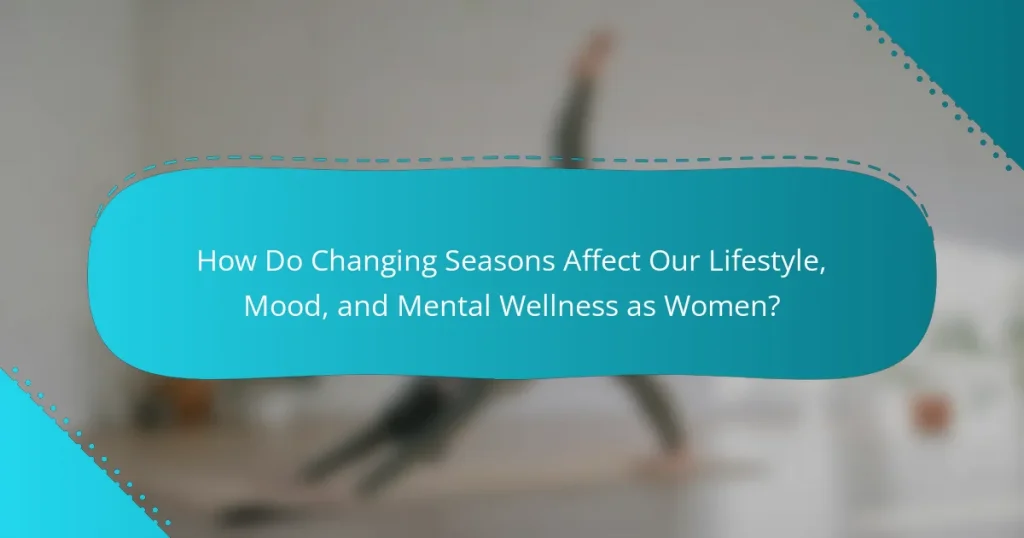Changing seasons can significantly influence women’s lifestyle, mood, and mental wellness. Seasonal Affective Disorder (SAD) may emerge in winter, while spring and summer often enhance mood through increased sunlight. Understanding these seasonal effects can help women develop coping strategies, including physical activity, social connections, and mindfulness practices. Nutrition and sleep patterns also play a crucial role in supporting mental health during these transitions.

How do changing seasons impact women’s mental wellness?
Changing seasons significantly impact women’s mental wellness, often leading to mood fluctuations. Seasonal Affective Disorder (SAD) is a unique attribute affecting many women, particularly in winter months due to reduced sunlight. The transition from summer to autumn can trigger feelings of sadness or anxiety because of shorter days and colder weather.
Conversely, spring and summer typically boost mood through increased sunlight and outdoor activities. Research indicates that exposure to natural light enhances serotonin levels, improving overall mental health. As a result, being mindful of these seasonal changes can help women adopt coping strategies to manage their mental wellness effectively.
Engaging in regular physical activity, maintaining social connections, and practicing mindfulness are beneficial approaches. Additionally, considering the role of nutrition and sleep patterns can further support mental health during seasonal transitions.
What are the common seasonal mood changes experienced by women?
Women often experience mood changes with seasonal shifts, including increased irritability and sadness during winter months, and heightened energy and optimism in spring. Seasonal Affective Disorder (SAD) affects many, leading to unique emotional challenges. Changes in daylight and weather can disrupt routines, impacting mental wellness. Engaging in outdoor activities and maintaining social connections can mitigate these mood fluctuations.
How does seasonal affective disorder (SAD) specifically affect women?
Seasonal affective disorder (SAD) significantly impacts women, leading to heightened mood swings and depressive symptoms. Women are more likely to experience SAD, with studies indicating they represent 60-90% of diagnosed cases. Symptoms often include fatigue, social withdrawal, and changes in sleep patterns. Hormonal fluctuations may exacerbate these effects, particularly during winter months when daylight decreases. Effective treatments include light therapy, psychotherapy, and medication, which can help alleviate symptoms and improve overall mental wellness.
What are the symptoms of SAD in women?
Women with Seasonal Affective Disorder (SAD) may experience symptoms like fatigue, irritability, and changes in sleep patterns. These symptoms often worsen during winter months due to reduced sunlight exposure. Commonly reported effects include difficulty concentrating, changes in appetite, and feelings of hopelessness. Unique attributes of SAD in women may involve hormonal fluctuations that can intensify mood changes. Addressing these symptoms through light therapy or lifestyle adjustments can improve overall mental wellness.
What are the risk factors for developing SAD as a woman?
Women face several risk factors for developing Seasonal Affective Disorder (SAD). These include hormonal fluctuations, particularly related to the menstrual cycle, which can impact mood. Additionally, women are more likely to experience SAD due to genetic predisposition and environmental factors, such as reduced sunlight exposure during winter months. Stress and a history of depression also increase susceptibility. Understanding these factors can help in developing strategies for managing mood and mental wellness throughout seasonal changes.
What lifestyle changes can women make during seasonal transitions?
Women can improve their lifestyle during seasonal transitions by adjusting routines, nutrition, and self-care practices. Adapting to seasonal changes can enhance mood and mental wellness.
In spring, women can engage in outdoor activities to benefit from increased sunlight, which boosts serotonin levels. Incorporating seasonal fruits and vegetables into meals supports overall health.
During summer, hydration becomes essential; increasing water intake helps maintain energy levels. Establishing a consistent sleep schedule can combat seasonal heat fatigue.
In autumn, women should focus on preparing for colder weather by incorporating warming foods and spices into their diets. Practicing mindfulness and gratitude can help manage the transition to shorter days.
Winter often brings challenges; maintaining physical activity indoors can alleviate seasonal affective disorder. Connecting with friends and family through social activities can enhance emotional support during this time.
How can diet influence mood in different seasons?
Diet significantly influences mood across different seasons by affecting nutrient levels and hormonal balances. In winter, comfort foods rich in carbohydrates can lead to temporary mood boosts, while in spring, fresh produce can enhance energy and positivity. Seasonal affective disorder (SAD) can exacerbate mood swings, making a balanced diet crucial. Incorporating omega-3 fatty acids in winter and vitamin D-rich foods in spring can support mental wellness.
What role does exercise play in seasonal mood management?
Exercise plays a crucial role in managing seasonal mood changes by enhancing mental wellness and emotional stability. Regular physical activity stimulates the release of endorphins, which improve mood and reduce feelings of anxiety. Research shows that women who engage in consistent exercise report lower levels of seasonal affective disorder (SAD) symptoms. Additionally, outdoor activities during changing seasons can provide exposure to natural light, further benefiting mental health. Incorporating exercise into daily routines can foster resilience against seasonal mood fluctuations.
How do seasonal changes affect sleep patterns in women?
Seasonal changes significantly impact sleep patterns in women due to variations in light exposure and temperature. Longer daylight hours in summer can lead to delayed sleep onset, while shorter days in winter may result in increased sleep duration. Research indicates that women are more sensitive to these changes, experiencing mood fluctuations and sleep disturbances. For instance, studies show that seasonal affective disorder (SAD) is more prevalent in women, affecting their overall mental wellness and sleep quality. Adjusting sleep environments and routines can help mitigate these seasonal effects, promoting better sleep hygiene.
What are the effects of daylight changes on sleep quality?
Daylight changes significantly impact sleep quality, particularly through variations in natural light exposure. Longer daylight hours in summer can lead to increased alertness and difficulty falling asleep, while shorter days in winter may enhance sleepiness but reduce overall sleep duration. Seasonal affective disorder (SAD) is a unique attribute that affects many women, linking reduced daylight to mood disturbances and sleep disruptions. Adjusting sleep schedules and incorporating light therapy can mitigate these effects, improving overall sleep quality and mental wellness.
What unique challenges do women face during seasonal transitions?
Women face unique challenges during seasonal transitions, including mood fluctuations and physical health changes. Hormonal variations can intensify symptoms of seasonal affective disorder, leading to depression and anxiety. Additionally, changes in weather may affect skin and hair health, causing discomfort. Social expectations around appearance can heighten stress during these transitions. Furthermore, women often juggle multiple roles, which can amplify feelings of overwhelm as seasons change. Addressing these challenges requires awareness and proactive self-care strategies tailored to individual needs.
How do hormonal fluctuations interact with seasonal changes?
Hormonal fluctuations significantly influence how women experience seasonal changes. Seasonal variations can affect mood, energy levels, and overall mental wellness due to shifts in hormone levels like oestrogen and progesterone.
For instance, during winter, reduced sunlight can lead to lower serotonin levels, contributing to seasonal affective disorder (SAD). In contrast, spring and summer may elevate mood due to increased daylight, which boosts serotonin production.
Additionally, hormonal changes throughout the menstrual cycle can intensify these seasonal effects. Women may experience heightened sensitivity to seasonal shifts during certain phases of their cycle, impacting lifestyle choices and emotional well-being.
Understanding these interactions can help women manage their mental wellness more effectively throughout the year.
What are the universal coping strategies for seasonal mood shifts?
Seasonal mood shifts can be managed through universal coping strategies. These include maintaining a routine, engaging in physical activity, practicing mindfulness, and seeking social support. Regular exposure to natural light and maintaining a balanced diet can also enhance mood stability.
How can mindfulness practices help during seasonal changes?
Mindfulness practices can significantly improve mood and mental wellness during seasonal changes. They enhance emotional regulation, reduce anxiety, and promote resilience. Engaging in mindfulness techniques like meditation or deep breathing helps women adapt to fluctuating energy levels and emotional states associated with seasonal transitions. As a result, these practices foster a greater sense of balance and well-being throughout the year.
What are effective social support strategies for women?
Effective social support strategies for women include building strong social networks, engaging in community activities, and utilizing online support groups. Women benefit from emotional connections that enhance resilience during seasonal changes. Regular check-ins with friends and family can help maintain mental wellness as seasons shift. Additionally, participating in group activities, such as exercise classes or book clubs, fosters a sense of belonging and reduces feelings of isolation.
What are some rare but notable seasonal effects on women’s mental health?
Seasonal changes can significantly impact women’s mental health, with rare effects often overlooked. For example, spring may trigger heightened anxiety in some women due to increased social expectations and seasonal allergies. Additionally, the transition from summer to autumn can lead to feelings of nostalgia and sadness as daylight decreases. Seasonal Affective Disorder (SAD) primarily affects women, with symptoms intensifying during winter months. Notably, some women experience a rare condition called “seasonal depression,” which can manifest in specific seasons, highlighting the complex interplay between environment and mental wellness. Understanding these unique effects can enhance awareness and promote better mental health strategies.
How can climate change influence women’s mental wellness across seasons?
Climate change can significantly impact women’s mental wellness throughout the seasons. Seasonal changes can exacerbate stressors linked to climate change, such as extreme weather events and environmental degradation.
Research indicates that women may experience heightened anxiety and mood disorders during these times. For instance, studies show that increased heat can lead to irritability and frustration, while prolonged winter conditions can contribute to feelings of isolation and depression.
Moreover, the unique attribute of women’s roles in caregiving can amplify stress, as they often bear the brunt of climate-related challenges in families. As a result, addressing these mental health concerns requires targeted support and resources that consider the intersection of gender and climate change.
What expert insights can help women navigate seasonal changes effectively?
Expert insights emphasize the importance of self-care and adaptability for women during seasonal changes. Engaging in regular physical activity can enhance mood and combat seasonal affective disorder. Mindfulness practices, such as meditation, can improve mental wellness by fostering resilience. Nutrition plays a crucial role; incorporating seasonal fruits and vegetables supports overall health. Social connections are vital; maintaining relationships can provide emotional support during transitions. Establishing routines can create stability, helping women navigate the emotional fluctuations that accompany seasonal changes.
What are the best practices for maintaining mental wellness year-round?
To maintain mental wellness year-round, women should adopt consistent self-care practices that adapt to seasonal changes. Engaging in regular physical activity boosts mood and energy levels, while mindfulness techniques help manage stress. Additionally, maintaining social connections is crucial for emotional support. Seasonal affective disorder can affect mood, so incorporating natural light exposure and vitamin D can be beneficial. Prioritising a balanced diet and adequate sleep also plays a significant role in overall mental wellness.
What common mistakes should women avoid during seasonal transitions?
Women should avoid neglecting self-care, overlooking nutrition, and resisting seasonal changes. These mistakes can lead to decreased mood and mental wellness. Prioritising self-care routines and adapting to seasonal shifts enhances overall well-being. For example, incorporating seasonal foods boosts energy and mood. Additionally, maintaining social connections during transitions can counteract feelings of isolation. Recognising the unique challenges posed by each season allows for proactive adjustments in lifestyle.




